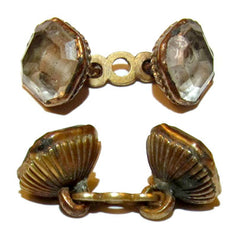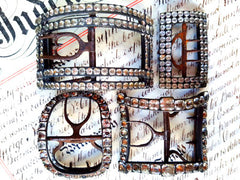Mudlarking: Colored Glass & Georgian Bling
By Jason Sandy

In the 18th century, the Georgians definitely loved their bling! To display their wealth and social status, both men and women dressed extravagantly for every occasion. Lasting from 1714 – 1830, the Georgian era was an age of opulence and indulgence. The British Empire expanded dramatically and flourished as a result of the lucrative trade deals with their colonies and other countries around the globe. Beachcombing finds from the River Thames in London reveal fascinating insights into Georgian fashion in the 18th century.
Exposed at low tide along the Thames, historical artefacts lay hidden amongst the gravel, sand, rusty iron, broken glass, and thick mud, waiting for centuries to be discovered and recovered. To find these evasive, fluvial treasures, I wear knee pads and sturdy rubber gloves, and I literally “get down and dirty.”
Last year as I was crawling on my hands and knees along the exposed river bed at low tide something suddenly caught my eye. Glistening in the glorious  sunshine, a sparkling green gemstone appeared in a small dip in the terrain. As a sea glass lover, this is one of my favourite glass finds from the River Thames. It is part of a Georgian cufflink from the 18th century. Over the years, I have found many of the single glass stones, but it took me several years until I found a complete set of cufflinks, still connected together by a decorated brass fastener (above). The dense, anaerobic (no oxygen) mud of the river bed perfectly preserves objects in the water-logged conditions. Many artefacts extracted from the black mud come out as radiant and lustrous as the day they were dropped in the river centuries ago.
sunshine, a sparkling green gemstone appeared in a small dip in the terrain. As a sea glass lover, this is one of my favourite glass finds from the River Thames. It is part of a Georgian cufflink from the 18th century. Over the years, I have found many of the single glass stones, but it took me several years until I found a complete set of cufflinks, still connected together by a decorated brass fastener (above). The dense, anaerobic (no oxygen) mud of the river bed perfectly preserves objects in the water-logged conditions. Many artefacts extracted from the black mud come out as radiant and lustrous as the day they were dropped in the river centuries ago.
What do these artefacts tell us about fashion in the 18th century? The Georgians were dressed to impress from head to toe – from white, powdered periwigs on their heads to sparkling, gem-encrusted shoe buckles on their feet. Fashion accessories were deliberately eye-catching and were a vital part of their attire. Each item was highly ornate and designed to glisten and sparkle. Decorated buttons, cufflinks, finger rings, and buckles were worn to catch attention, especially of the opposite sex.
 Monarchs and aristocracy could afford precious gemstones set in gold and silver jewellery, but the middle class wore cheap, inexpensive alternatives to imitate the upper-class fashion trends. Instead of gold and silver, they used shiny brass which glistened like gold or polished pewter which appeared like silver. Instead of diamonds and precious gemstones, they would use cut, colored glass which sparkled like real gemstones.
Monarchs and aristocracy could afford precious gemstones set in gold and silver jewellery, but the middle class wore cheap, inexpensive alternatives to imitate the upper-class fashion trends. Instead of gold and silver, they used shiny brass which glistened like gold or polished pewter which appeared like silver. Instead of diamonds and precious gemstones, they would use cut, colored glass which sparkled like real gemstones.
The glass paste stones enhanced the appearance of their cufflinks, shoe and knee buckles, and finger rings. Georgian cufflinks found in the River Thames exhibit a vast array of designs, patterns, colors, and glass paste stones. Although the first cufflinks appeared in the late 17th century, they did not become popular  until the 18th century. Their development is closely related to the changing fashion in men’s shirt designs. Before the 1680’s, shirt sleeves were more commonly tied at the cuff with ribbons. With the introduction of the French cuff in the mid 1600’s, cufflinks had a practical purpose of holding the cuffs together. Cufflinks quickly became a vital fashion accessory and adornment. As new techniques were developed, cufflink makers began to include illustrations or lettering on the underside of the glass paste stone. Portraits of military heroes or slogans of outspoken politicians were sometimes pressed into the surface of the glass and set into the cufflinks.
until the 18th century. Their development is closely related to the changing fashion in men’s shirt designs. Before the 1680’s, shirt sleeves were more commonly tied at the cuff with ribbons. With the introduction of the French cuff in the mid 1600’s, cufflinks had a practical purpose of holding the cuffs together. Cufflinks quickly became a vital fashion accessory and adornment. As new techniques were developed, cufflink makers began to include illustrations or lettering on the underside of the glass paste stone. Portraits of military heroes or slogans of outspoken politicians were sometimes pressed into the surface of the glass and set into the cufflinks.

While mudlarking along the River Thames in August 2017, I found a small, unassuming cufflink from the 18th century which contained a glass stone set in a decorated pewter setting. Although the glass stone was worn down by tide and time, I thought I could see some letters through the glass. Using a magnifying glass, I could read the words, “Wilkes and Liberty No. 45”, which were barely legible through the cloudy surface of the stone. While researching the cufflink, I discovered that John Wilkes (1727-1797) had been a Member of Parliament and was famous both in Britain and America for his fight against government oppression and for his rebellion against the King of England. In 1763, he wrote an essay (No. 45) in The North Britain newspaper which aggressively criticized the king.
King George III was so outraged by the essay that he ordered John Wilkes to be arrested. Fearing for his life, Wilkes fled the country but was imprisoned upon his return. Cries of “Wilkes and Liberty!” were heard across London, as people desperately sought political change. John Wilkes became an icon and symbol of the powerless against the privileged. Georgian men wore cufflinks with the words, “Wilkes and Liberty No. 45,” to show their support for his cause. According to Ward Oles, a researcher of 18th century material culture, “Wilkes and Liberty” cufflinks have been found in tightly dated Colonial period archaeological sites in North America which is an indication of Wilkes’ influence on the “Sons of Liberty.”
After Wilkes’ death, many children in England and America were named “John Wilkes” in his honour. A century later, the most infamous was the American, John Wilkes Booth, who was a distant relative of the original John Wilkes. Like his British ancestor, John Wilkes Booth was also politically active and voiced his strong opinions. He was a Confederate sympathizer and strongly opposed the abolition of slavery during the American Civil War. Four days after the Confederate army surrendered to the Union army in Virginia, John Wilkes Booth decided to take matters into his own hands. He successfully achieved his ultimate political goal: he cold-heartedly assassinated the United States President, Abraham Lincoln, as he watched a performance at Ford’s Theatre in Washington D.C. on April 14, 1865. It was one of the darkest days in U.S. history. It’s amazing that this extraordinary glass cufflink, which I found of the Thames foreshore, revealed an incredible backstory and unique chapter in British and American history.

Mudlarks in London have also found a wide range of Georgian buckles buried in the mud of the River Thames foreshore. Shoe buckles had been in intermittent use since the 13th century, but it was not until the late 17th and 18th centuries that they were particularly en vogue and worn as impressive status symbols.  Some of the most extraordinary Georgian buckles have been inlaid with real gemstones or glass paste stones. Improvements in glass paste stone production and cutting methods during the late 17th and early 18th centuries gradually increased the luminosity and brilliance of the glass stones. However, the major improvement came in the 1760’s when a silver foil was placed behind the glass stones. The silver foil acted as a mirror, making the glass paste stones appear larger than they actually were and vastly improved their facetted sparkle. Shoe buckles were produced in all shapes and sizes, and the cut glass stones were arranged to compliment the geometry of the buckle frame. Worn as a flashy display of their wealth and social status, the cut glass stones would glisten, dazzle, and create an eye-catching appearance in the sunlight).
Some of the most extraordinary Georgian buckles have been inlaid with real gemstones or glass paste stones. Improvements in glass paste stone production and cutting methods during the late 17th and early 18th centuries gradually increased the luminosity and brilliance of the glass stones. However, the major improvement came in the 1760’s when a silver foil was placed behind the glass stones. The silver foil acted as a mirror, making the glass paste stones appear larger than they actually were and vastly improved their facetted sparkle. Shoe buckles were produced in all shapes and sizes, and the cut glass stones were arranged to compliment the geometry of the buckle frame. Worn as a flashy display of their wealth and social status, the cut glass stones would glisten, dazzle, and create an eye-catching appearance in the sunlight).
Glass finds from mudlarking and beachcombing along the River Thames are absolutely fascinating, not only for their inherent beauty, but because of the extraordinary bits of history they reveal. The exquisitely crafted Georgian glass cufflinks, finger rings set with glass stones, and gem-encrusted buckles give us intriguing insights into the fashions and popular culture of the 18th century. The Georgian Era was certainly an age of opulence and indulgence, and the custom-made glass artefacts recovered from the River Thames prove that the Georgians loved their bling!
For more about toggles, clasps, dress fasteners, hooked tags, and cufflinks, read Mudlarking: Keep It Together! Dress Fasteners and Cufflinks.
Mudlarking on the Thames Foreshore requires a permit. Learn about rules for mudlarking in London ›
View some of Jason's favorite Thames River mudlarking finds
Learn more about mudlarking
Learn more about the experiences of mudlarks, who search the shores of rivers, bays, and seas for historical finds and other objects. Articles ›
This article appeared in the Glassing Magazine March/April 2018 issue.








